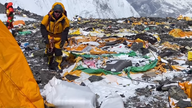Spy satellite images reveal Himalayan glaciers are shrinking fast
Glaciers have been shrinking by almost half a metre each year since 2000, Cold war-era spy satellite images reveal.
Thursday 20 June 2019 11:07, UK
Himalayan glaciers are now melting twice as fast as they were before the turn of the century, Cold War-era spy satellite images have revealed.
The melting of ice in the Asian mountain range, which includes Mount Everest, has doubled during the last 40 years, according to a new study by scientists.
The team, from Columbia University's Earth Institute, compared US spy satellite images from the mid-1970s with modern satellite data.
They examined 650 glaciers spanning 2000km (1,243 miles) across India, China, Nepal and Bhutan.
Analysis showed glaciers have been shrinking by almost half a metre each year since 2000 - twice the amount lost every year between 1975 to 2000.
More than a quarter of the ice that was present in 1975 has vanished during the last four decades.
"This is the clearest picture yet of how fast Himalayan glaciers are melting over this time interval, and why," said lead author Joshua Maurer, from Columbia University's Lamont-Doherty Earth Observatory in New York.
Recent yearly losses have averaged about 8 billion tonnes of water - the equivalent of 3.2 million Olympic-size swimming pools, he said.
Though temperatures vary from place to place, average temperatures were one degree Celsius (1.8F) higher between 2000 to 2016 than they were between 1975 and 2000.
As well as rising temperatures, other causes included reduced rainfall and the burning of fossil fuels as soot landing in the region absorbs sunlight and speeds up melting.
"It shows how endangered [the Himalayas] are if climate change continues at the same pace in the coming decades," said Etienne Berthier, a glaciologist at France's Laboratory for Studies in Geophysics and Spatial Oceanography, who was not involved in the study.
The study has been published in the journal Science Advances.




